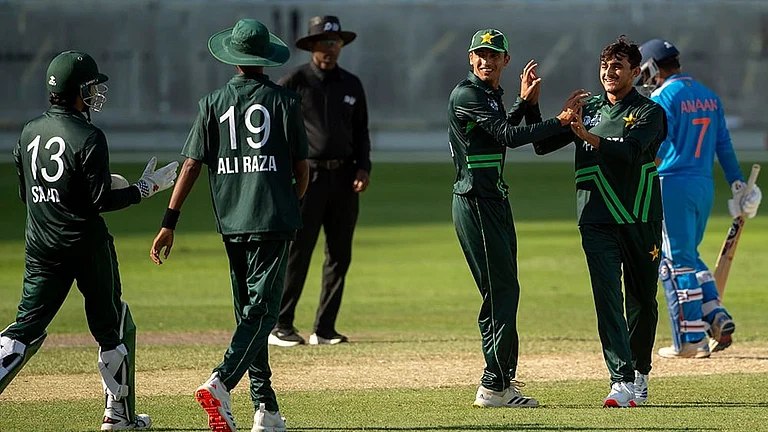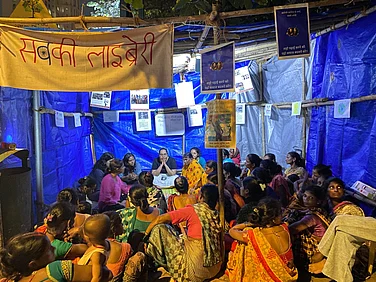For the past two years, celebrated Kashmiri artist Masood Hussain has been working on a project called ‘Samanbal’. In Kashmiri, Samanbal means a meeting place and it is aimed to become a residency for artists. Slowly, Hussain’s vision for the Samanbal Art Residency is taking shape with him overseeing its construction.
Hussain is Samanbal’s mason. he is also its carpenter, labourer, architect, engineer, and, above all, its artist. He has been to different places in the Valley to gather material for the art residency. He visits the old city of Srinagar to find and purchase windows and doors from old houses. He searches for archaic bricks and discarded and broken tiles for the residency. He has been making insulation for the residency using grass slabs. He has been selecting broken glasses to make chandelier lights for the Samanbal.
Hussain has long waited to fulfil this dream and he loves to talk about it.
“It will be a residency for artists to stay, paint, and talk about art, culture, poetry, and society,” says Hussain passionately at his home in uptown Jawahar Nagar.
Hussain loves to share pictures and videos of Samanbal and imagines how it will look during different seasons in Kashmir.
For Hussain, two years have been spent travelling up and down from Astan Marag on the outskirts of Srinagar and joining labourers there to complete Samanbal. The progress has been slow. The road to Samanbal lies along the Dal Lake, Mughal gardens, Dachigam National Park, and Harwan. Astan Marg —Valley of Shrines— is also up in the highlands, giving a panoramic view of Srinagar, its habitants, and the surrounding mountains.
“It will take some more time to complete the interiors. At least, around 10 artists should be able to stay there,” Hussain says with a smile on his face.
Hussain is well aware of the struggle of artists in Kashmir for the past seven decades to find a space where they could sit together and discuss art. He feels artists in Kashmir have been isolated as they could not find the space. Indefatigable Hussain has decided to do this work for Kashmiri art and artists.
Art in Kashmir over the years
Kashmir has a rich history of art from the Buddhist period and this is evident from the collections at the SPS Museum in Srinagar. There are collections from the 2nd century with bronze sculptures, clay images, woodwork, metalwork, musical instruments, and miniature paintings, indicating the richness of the artistic landscape in the Valley.
In the 1940s, it was eminent painters Dr Percy Brown and Syed Hyder Raza who gave art a new direction in Kashmir. Dr Percy Brown settled in Kashmir in 1943 and bought a houseboat named Catherine near the old Srinagar Club. He died in 1955 and lies buried inside Sheikh Bagh Cemetery, Amira Kadal, Srinagar. Brown and Raza acted as patrons and guides to artists from Kashmir. Raza met Kashmiri painters SN Bhat, Trilok Koul, PN Kachru, Nisar Aziz, and guided them about modern art.
Later Ghulam Rasool Santosh, Nisar Aziz, Bansi Parimo, Mohan Raina, and others joined them and established an association called Kashmir Progressive Artists Group. Abanindranath Tagore frequently travelled to the Valley and would usually stay at historian Anand Koul Bamzai’s house in Zaina Kadal, Srinagar.
In the 1960s, Kashmir would host artists from different states for two weeks and during the cultural carnival the artists would give two paintings to the cultural academy. That is why J&K Academy of Art, Culture, and Languages has a collection of works of great artists, including MF Hussain, FN Souza, Santosh, Bansi Parimo, and others.
Hussain says the early ‘60s saw the emergence of another generation of artists who significantly contributed to the revival of the art of sculpture. As the artists were trained at Baroda, they inherited the richness of expression from NS Bendre, Sankho Choudhury, and KG Subramanyan.
Many artists, including Santoosh, PN Kachru, and others, started Kashmir’s art movement and then moved out. They exhibited their art in Mumbai and other places.
Breaking taboos around sculpture
Late Shujah Sultan in his essay Troubled Testimonies talks about another generation that gave the art new orientation and objective in Kashmir in the 1970s. VR Khajuria laid the foundation for the revival of sculpture in Jammu and Gayoor Hassan had a difficult task in Kashmir. He was breaking the religious taboo attached to the sculpture.
“It needed firm conviction and sincerity of purpose to convey the idea that the art of sculpture was not the art of image-making; it was an essential means of expression,” Sultan writes while describing Gayoor’s art.
In his early years, Gayoor Hassan did some remarkable works in the tradition of Henry Moore. He was desperately in need of a subject that belonged to his soil. After years of study, he found solace in the spiritual traditions of Kashmir, especially in the Buddhist context. Drawing inspiration from Buddhist meditative mudras and postures, he enriched the art scenario. Sadhna —meditation— therefore, remained his favourite subject and, according to him, meditation alone can retrieve mankind from crises.
Art in Kashmir of 1970s
In the 1970s, the Cultural Academy started “hobby classes” at Jawahar Nagar, close to its residence of Hussain. In those days, the Art College had come up in Kashmir in Jawahar Nagar. And Hussain started attending it and studied in the Art College for a year before moving to JJ School of Applied Arts, Bombay.
Those were relatively peaceful years and artists were fighting for an art gallery. The art was also peaceful. Senior artists would come from outside and would try to promote Kashmiri art. The art camps in the Valley used to be a big attraction for top artists in the country.
“Artists usually paint those very things that happen around them. In those days, artists painted Kashmir, mostly landscapes, houseboats, Dal Lake, and colours. The story was of beauty, culture, peace around them and whatever they saw,” says Hussain, talking about the 1970s in Kashmir.
He says artists would meet at a lone coffee house in Srinagar interacting with writers, poets, TV artists, and intellectuals of the society and discussions were mostly about art, culture, and literature. They also had grievances and desires also — desire to have an art gallery in Kashmir and wish to have space for art activities.
How insurgency affected Kashmir’s art
Then insurgency and protests began in the Valley in 1989-1990. It shook everyone in Kashmir. Most Kashmiri Pandit artists left the Valley. While Kashmir pandit artists painted about their migration and life in exile, Hussain and others painted about the everyday struggle of people in the Valley.
As artists are not oblivious to what is happening around them, Sultan says, Masood Hussain's expressions become more collaborative as he zooms closer into day-to-day happenings. This is evident in his works in which these realities are projected.
“His works Red Sun, How Many More, and The Procession, define the horror and pathos of death, claiming innocent lives like an epidemic attack of bullets,” Sultan writes.
The 'Stampede' derives its inspiration from the CRPF firing on a funeral procession of the late Mirwaiz Moulvi Mohammad Farooq in January 1990. On the next day of the incident, Hussain visited the spot and saw hundreds of shoes and slippers. This gave him the idea for The Stampede.
Similarly, ‘How Many More’ is representative of the martyrs’ graveyard in Srinagar, where spaces have been filled in with the bodies of the dead while other vacant spaces appear ‘open-mouthed’ to devour still more, as stated by Sultan. In his paintings, Hussain is not seen as philosophising the situation.
“Masood Hussain merely acts as a chronicler of an unfortunate period of history,” writes Sultan.
In 1990, he lost hundreds of paintings in the studio he had opened in Hazuri Bagh in a fire incident.
“After the fire, I went to the studio. There was nothing except for a burnt transformer. Since then, what I have painted, I have painted from what I saw and nothing else,” he adds.
The post-1990 turmoil had a deep impact on artists. The beauty of Kashmir went into the background and the day-to-day happenings became part of the art. It was true about all artists, poets, and music composers. Kashmiri poet Agha Shahid Ali chose Hussain’s painting for his book The Country Without A Post Office.
But over the years, artists from Kashmir have faced difficulty in exhibiting their works outside the Valley, while within the Valley artists don’t interact with each other.
“I feel that artists of the Valley need a place to sit and discuss art. A place where outside artists will come and interact with each other. There is an artistic community outside the Valley. They know where to go and where to exhibit their work. I am seeing several artists coming from outside, painting in Kashmir, and then leaving. I think there is a lot of opportunity in this for us,” says Hussain.
Hussain is hopeful that his Samanbal will act as a confluence of artists from outside and inside Kashmir.


























